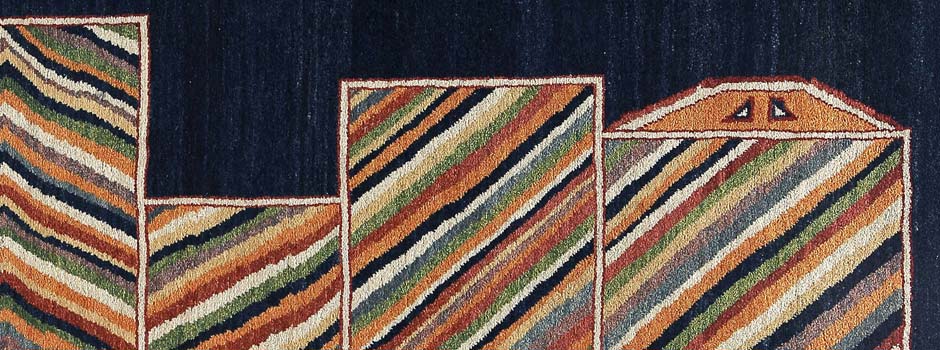
Parviz Tanavoli: Rugs Collection
Jan 09, 2013 Art Collection

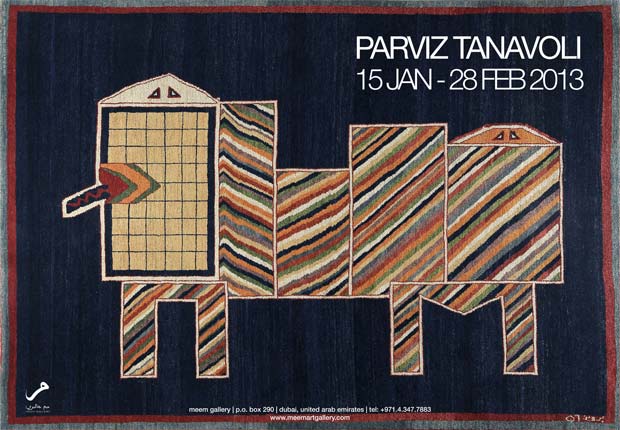 Parviz Tanavoli: Rugs Collection Poster / Courtesy of Meem Gallery
Parviz Tanavoli: Rugs Collection Poster / Courtesy of Meem Gallery
Meem Gallery is pleased to present an exhibition of Parviz Tanavoli’s recent rugs collection. More commonly known for his sculptures and as one of the founders of the ‘Saqqakhaneh School’, Tanavoli has for many decades researched, written about, collected and created rugs. The artist’s ongoing interest in Iranian visual culture has pervaded his artistic practice, which spans over fifty years, as well as his creation of rugs: pictorial, lion, prayer design, and gabbeh. Subjects explored in his rug designs are not only culled from the tribal and nomadic arts and culture of Iran but from the themes found in his art, such as Farhad the Mountain Carver, Lovers, Poet, Lion, Bird and Cage. He also draws inspiration from traditional Persian literature, most notably the mythological stories of King Hushang Shah and Sheikh San’an. In 1973, Tanavoli founded the Tehran Rug Society, organizing two tribal weave exhibitions in 1975 and 1976.
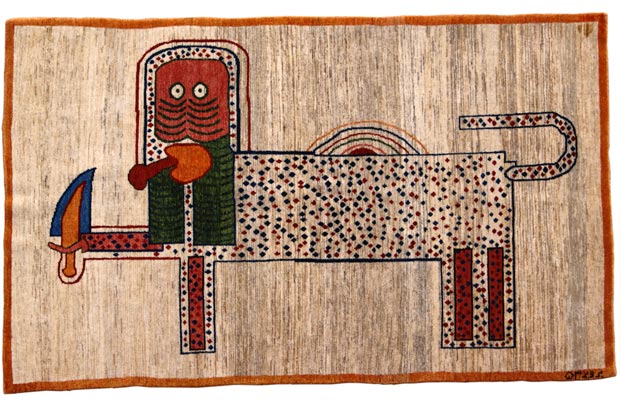 Parviz Tanavoli: Rugs Collection / Lion and Sword III, 1974, Bijar weave, 121x199 cm / Courtesy of Meem Gallery
Parviz Tanavoli: Rugs Collection / Lion and Sword III, 1974, Bijar weave, 121x199 cm / Courtesy of Meem Gallery
The first solo exhibition displaying his rug designs was held in Tehran’s Zand Gallery in 1978. From 1975-92 his Lion Rugs of Fars exhibition, which displayed his personal collection of lion rugs, toured the US, Canada, UK, Germany, Switzerland, Australia and Iran. Following the 1979 revolution, and the Iran-Iraq war, socio-political circumstances prevented him from displaying his sculptures in Iran, leading him to focus on designing and producing gabbehs. His first gabbeh exhibition was held in Vienna’s Bessim Gallery in 1986, followed by others in London, Zurich and Cologne. A selection of his rugs are held at the Tate Modern, London, Kerman Museum and in several private collections. This is Tanavoli’s second exhibition—in 2009 his sculptures were exhibited alongside photographic works by Abbas Kiarostami—at Meem Gallery. His work was also presented by Meem at the Abu Dhabi Art Fair in 2010 and 2011; the first display exhibited a selection of Tanavoli’s bronze sculptures (alongside the paintings of Iraqi artist, Dia Azzawi), and the second display showcased his monumental, stainless-steel, heech sculpture.
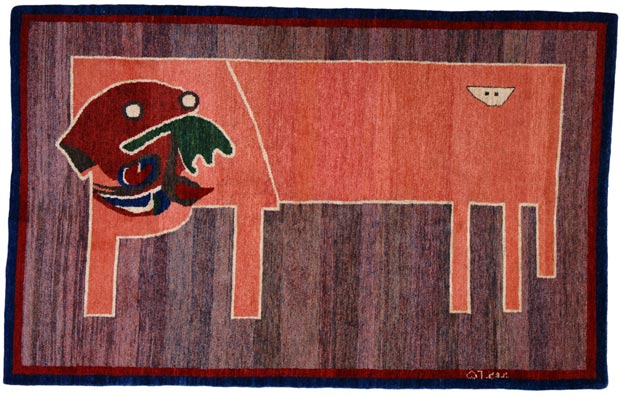 Parviz Tanavoli: Rugs Collection / Pink Lion, 1977, Bijar weave, 124x193 cm / Courtesy of Meem Gallery
Parviz Tanavoli: Rugs Collection / Pink Lion, 1977, Bijar weave, 124x193 cm / Courtesy of Meem Gallery
Parviz Tanavoli (b. 1937, Tehran) is one of Iran’s foremost artists, considered as the country’s first significant modern sculptor. A central figure in the formation of the Saqqakhaneh School—a neo-traditional style of art that derives inspiration from Iranian folk art and culture - Tanavoli has created works in bronze, ceramic, fiberglass and scrap metal. His oeuvre displays a deep engagement with Persian folkloric traditions, poetry and literature, all expressed in a recurring series of subjects, including the calligraphic figure of Heech (Nothingness), Farhad the Mountain Carver, Lock, Poet, Prophet, Lovers, Walls, Hand, Lion and Bird. Additionally, Tanavoli is a prolific writer. He has authored numerous books and articles on the artistic culture of Iran, featuring in publications such as Hali, Tavoos and Oriental Rug Review.
He has held solo exhibitions in Iran, Europe, US and Canada and participated in numerous biennales and group exhibitions including, Contemporary Art from the Islamic World, Barbican Centre, London, 1989; Continental Shift, Museums of Aachen, Maastricht, Heerlen and Liège, 2000; Picturing Iran: Art, Society and Revolution, Grey Art Gallery, New York, 2002; Word into Art, British Museum, London, 2006; and Contemporary Iranian Art from the Permanent Collection, Metropolitan Museum of Art, New York, 2012. His works are housed in international private and public collections, including the British Museum and Tate Modern, in London; Metropolitan Museum of Art, MoMA, Nelson Rockefeller Collection, and Grey Art Gallery, New York University Collection, in New York; Hamline University, St. Paul, Minnesota; Esfahan City Center; Museum of Modern Art, Vienna; Olympic Park, Seoul; DIFC, Dubai; and Jordan National Gallery of Fine Arts, Amman.
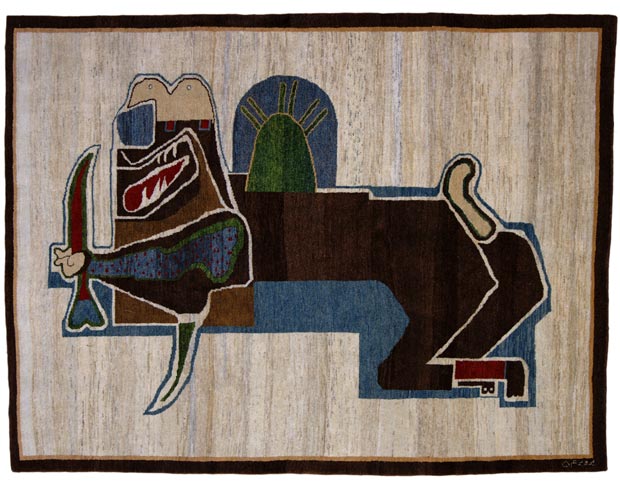 Parviz Tanavoli: Rugs Collection / Lion and Sword II, 1979, Bijar weave, 158x208 cm / Courtesy of Meem Gallery
Parviz Tanavoli: Rugs Collection / Lion and Sword II, 1979, Bijar weave, 158x208 cm / Courtesy of Meem Gallery
Tanavoli graduated from the Fine Arts School in Tehran in 1956, after which he travelled to Italy, where he studied at the Accademia di Belle Arti in Carrara. Returning to Iran two years later, Tanavoli exhibited his work- including prints, ceramic and scrap metal sculptures- at Farhang Hall, marking the first sculpture exhibition in Iran and gaining him critical acclaim. In 1959, after receiving a highly coveted scholarship, he returned to Italy to study at the Brera Academy in Milan, under the sculptor Marino Marini, graduating with honours in 1959.
 Parviz Tanavoli in a Qashqa’i tent, 1995 / Courtesy of Meem Gallery
Parviz Tanavoli in a Qashqa’i tent, 1995 / Courtesy of Meem Gallery
Upon his return to Tehran in 1960, Tanavoli helped establish the curriculum for the newly established College of Decorative Arts - where he also taught sculpture - with artists Houshang Kazemi, Asad Behroozan and Bijan Saffari. The same year, he set up the Atelier Kaboud, a personal studio, funded by the head of the Fine Arts Administration, Mehrdad Pahlbod, which became an artistic hub for contemporary Iranian artists. The studio was the primary setting for the establishment of the Saqqakhaneh School and the Contemporary Artists Group. A year later, after meeting the American art collector Abby Grey at a group exhibition in Saderat Bank, Tanavoli travelled to Minnesota as an artist-in-residence at the Minneapolis College of Art, later accepting a teaching post there. There he began working in bronze, exploring a variety of themes including the Poet, Prophet and Lovers, and was introduced to the contemporary arts scene in the United States, most notably Pop art.
 Parviz Tanavoli: Rugs Collection / Poet and Nightingale, 1975, Bijar weave, 236x182 cm / Courtesy of Meem Gallery
Parviz Tanavoli: Rugs Collection / Poet and Nightingale, 1975, Bijar weave, 236x182 cm / Courtesy of Meem Gallery
In 1964, he returned to Iran, with equipment donated by the Grey Foundation, to teach sculpture in the Fine Arts Faculty of Tehran University. A year later, he introduced the Iranian art world to the now legendary heech series. In 1979, Tanavoli retired as head of the sculpture department at Tehran University and left Iran with his family to settle in Vancouver. During this time, he published extensively on the crafts traditions of Iran, travelling to the country regularly for research and continuing to exhibit his works and collections internationally.
Comments
Nov 27, 2013 - 20:54:12
The craftsman’s continuous engage in Iranian visual society has swarmed his imaginative practice, which compasses over fifty years, and his making of mats: pictorial, lion, petition to God outline, and gabbed.
Add a comment